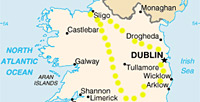 In October 2003, Beliefnet inaugurated its spiritual travel program with a trip to Ireland. The goal was to provide a soul journey for our travelers--an experience they could bring back home. Here's what we did.
In October 2003, Beliefnet inaugurated its spiritual travel program with a trip to Ireland. The goal was to provide a soul journey for our travelers--an experience they could bring back home. Here's what we did.
Day 1--Dublin
The spiritual adventure begins! After a morning of sleep to get over our night flight, the group gathers in our Dublin hotel for a Celtic Circle--a time to share our stories and get to know each other. Beliefnet guide Carl McColman lights four candles for each of the four directions, with a fifth candle in the center.
After Carl's brief introduction to Celtic spirituality--including bards, seers, druids, and the Irish concept of anam cara, the soul friend--we set off for a tour of Dublin. First stop: St. Patrick's Cathedral.
 At the cathedral, we see the Door of Reconciliation, a wooden door with a slot hacked through it. The story goes that two earls were feuding; one decided to call off the quarrel, so he cut a slit in the wooden door of St. Patrick's and stuck his hand through to his rival for a handshake. The other had a decision to make: cut off his rival's hand, or shake it and declare peace. Guess what happened? It's a lesson to take the risk to forgive, says our guide.
At the cathedral, we see the Door of Reconciliation, a wooden door with a slot hacked through it. The story goes that two earls were feuding; one decided to call off the quarrel, so he cut a slit in the wooden door of St. Patrick's and stuck his hand through to his rival for a handshake. The other had a decision to make: cut off his rival's hand, or shake it and declare peace. Guess what happened? It's a lesson to take the risk to forgive, says our guide.
Overhead: "When you say a prayer, it's received as song."
 On to the Book of Kells, one of the oldest illuminated manuscripts of the gospels. We peer at the beautifully detailed images and debate which symbol represents Luke's gospel: is it an ox or something else? Heading out, we pause on a nearby street for a photo shoot with a statue of Molly Malone, immortalized in the "wheeled her wheelbarrow" song.
On to the Book of Kells, one of the oldest illuminated manuscripts of the gospels. We peer at the beautifully detailed images and debate which symbol represents Luke's gospel: is it an ox or something else? Heading out, we pause on a nearby street for a photo shoot with a statue of Molly Malone, immortalized in the "wheeled her wheelbarrow" song.
That evening, a night of good food and a lively Irish dance performance in the country's biggest thatched roof pub. They raise the floor so we can see the dancers' intricate steps. Riverdance, eat your heart out.
Day 2--Glendalough
After morning meditation, Carl talks about the great gods and heroes of Irish mythology: Cuchulain, Maeve, Oisin, Danu, and more. Unanswered question: Were the fairies neutral angels?
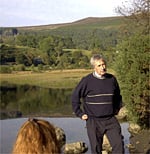 We set off on a cloudless day for the hills and lakes of Glendalough, where Father Michael Rodgers meets us. As he leads us through breathtaking mountain scenery to sites associated with Saint Kevin, Fr. Michael recites lines from the poem "Child of Wonder": "Take off your shoes/The ground where you stand is holy." We look over the sparkling lake to see Kevin's Bed, a cave where the saint was said to have prayed and slept. The area, our guide explains, is a thin place--a place where earth and heaven touch.
We set off on a cloudless day for the hills and lakes of Glendalough, where Father Michael Rodgers meets us. As he leads us through breathtaking mountain scenery to sites associated with Saint Kevin, Fr. Michael recites lines from the poem "Child of Wonder": "Take off your shoes/The ground where you stand is holy." We look over the sparkling lake to see Kevin's Bed, a cave where the saint was said to have prayed and slept. The area, our guide explains, is a thin place--a place where earth and heaven touch.
Fr. Michael ends the tour near a second lake where St. Kevin was supposed to have met a wormlike monster. Rather than destroy it, Kevin took it with him, says the legend. "The question is, what [worm] is eating us?" asks Fr. Michael.
After quick sweater shopping and lots of salmon at dinner, several brave souls sally forth on a nighttime nature outing. Carrying candles, we stop at one of Glendalough's rocky streams to sing together, and then meditate in silence on the beauty around us.
Overheard: Guide Carl McColman saying the trip "will be one miracle after another."
Day 3--Kildare
 Heady conversation at breakfast: some in the group discuss Orthodox icon-painting, others Henri Nouwen and Thomas Merton. We pack up and head for Kildare, a town steeped in the lore of the Celtic goddess/Christian saint Brigid. Brigid, Carl explains on the bus, was a "walker between the worlds"--a woman who, legend says, was literally born on a threshold and continues to speak to both pagans and Christians.
Heady conversation at breakfast: some in the group discuss Orthodox icon-painting, others Henri Nouwen and Thomas Merton. We pack up and head for Kildare, a town steeped in the lore of the Celtic goddess/Christian saint Brigid. Brigid, Carl explains on the bus, was a "walker between the worlds"--a woman who, legend says, was literally born on a threshold and continues to speak to both pagans and Christians.
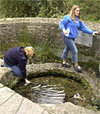 We're warmly welcomed at the home of Sister Mary Minehan, where we spend a few minutes in prayer and discussion about Brigid. Sister Mary takes us to the Cathedral of St. Brigid, with its prayer hole carved in one corner. Stick your arm through the hole and touch your opposite shoulder, they say, and your heart's wish will come true, so of course we try it. Inside the church, Carl points out one tomb's sheela-na-gigs, pagan stone carvings of nude females often found, surprisingly, in the British Isle's older churches.
We're warmly welcomed at the home of Sister Mary Minehan, where we spend a few minutes in prayer and discussion about Brigid. Sister Mary takes us to the Cathedral of St. Brigid, with its prayer hole carved in one corner. Stick your arm through the hole and touch your opposite shoulder, they say, and your heart's wish will come true, so of course we try it. Inside the church, Carl points out one tomb's sheela-na-gigs, pagan stone carvings of nude females often found, surprisingly, in the British Isle's older churches.
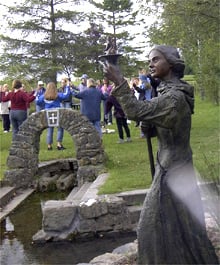 On the cathedral grounds is the restored foundation of the ancient fire temple where priestesses, and later nuns, kept the flame of Brigid burning until the sixteenth century. After stairmaster types climb the round tower in the churchyard, we're off to two holy wells dedicated to Brigid. At the first, we gather holy water to take home; at the second, we dance a circle dance around several of five stones representing Brigid's aspects as peacemaker, earthwoman, and more. Hear an audioclip of Tread Gently, the music we danced to. An Irish family on pilgrimage to the site asks to join our dance, and then requests that we pray for their mother, who is ill.
On the cathedral grounds is the restored foundation of the ancient fire temple where priestesses, and later nuns, kept the flame of Brigid burning until the sixteenth century. After stairmaster types climb the round tower in the churchyard, we're off to two holy wells dedicated to Brigid. At the first, we gather holy water to take home; at the second, we dance a circle dance around several of five stones representing Brigid's aspects as peacemaker, earthwoman, and more. Hear an audioclip of Tread Gently, the music we danced to. An Irish family on pilgrimage to the site asks to join our dance, and then requests that we pray for their mother, who is ill.
Overhead: Carl: "Holy wells are the anti-McDonald's--every one is unique."
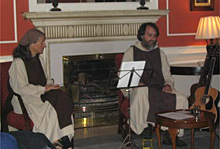 We say farewell to Kildare and head for Cashel, Ireland's most spectacular castle. There, we're met by Sister Susan Ryan and Father Tom Renaud, monks from Colorado's Spiritual Life Institute who now live in Ireland. Before dinner, Sister Suzie and Father Tom grace us with their considerable musical talents in the hotel's comfy sitting room.
We say farewell to Kildare and head for Cashel, Ireland's most spectacular castle. There, we're met by Sister Susan Ryan and Father Tom Renaud, monks from Colorado's Spiritual Life Institute who now live in Ireland. Before dinner, Sister Suzie and Father Tom grace us with their considerable musical talents in the hotel's comfy sitting room.
It's a free night, so the group heads off to socialize in Cashel's pubs. Some have a little trouble finding veggie cuisine in the small town, but manage it.
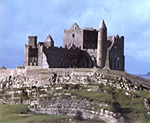 After meditation with Carl and Falun Gong exercises with our Sacred Travel liaison (always optional for those who stayed out late), Father Tom gives a brief talk about prayer: "Set aside your best time for it."
After meditation with Carl and Falun Gong exercises with our Sacred Travel liaison (always optional for those who stayed out late), Father Tom gives a brief talk about prayer: "Set aside your best time for it."
Carl tells us more about holy wells: Don't insult one or it may relocate! Carl notes that today is the feast day of Saint Francis, patron of nature, and regrets how the environment is not always held sacred: Brigid's well holds the "water of my goddess, and because of local construction I can't drink it."
Quotable: Fr. Tom: "The best indicator of a good prayer life is whether you're loving better."
After breakfast, we walk through the lovely hotel garden up a hill to Cashel. Standing high up in the ruins of the ancient castle, the views of the countryside are amazing. Participants of Irish descent scan the many gravestones around the castle, hoping to find genealogical clues.
Time to head north to Clonmacnoise and Sligo. Sister Suzie joins us on the bus, and one of our own goes with Fr. Tom in his car, where they discuss St. John of the Cross' dark night of the soul.
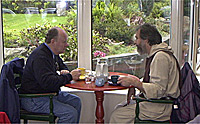 We stop at a sunlit garden restaurant on the road from Cashel to Sligo, where group members talk with Fr. Tom and the other guides.
We stop at a sunlit garden restaurant on the road from Cashel to Sligo, where group members talk with Fr. Tom and the other guides.
Our next stop is Clonmacnoise, Ireland's most extensive monastic settlement. Taking in views of the River Shannon, we walk (and sometimes wriggle) through the ruins of early Christian buildings and hear the story of Saint Ciaran. One participant decided to leave her camera behind on the trip--and sketched instead.
 Watching the 1952 classic "The Quiet Man" on the late afternoon bus ride, the feminists among us try to find camp value in the shrewish Maureen O'Hara. But it's difficult with the phrase "here's a good stick to beat the lovely lady with." As the credits roll, we arrive in Sligo, a town bordering the ocean.
Watching the 1952 classic "The Quiet Man" on the late afternoon bus ride, the feminists among us try to find camp value in the shrewish Maureen O'Hara. But it's difficult with the phrase "here's a good stick to beat the lovely lady with." As the credits roll, we arrive in Sligo, a town bordering the ocean.The evening's talk with Susan Starkey, a laywoman in residence with her husband at Holy Hill Hermitage, is interactive: We look at four cards with different symbols and choose the one we feel the most affinity for.
 If you choose the one to the left, your assigned prayer begins:
If you choose the one to the left, your assigned prayer begins:
The shelter of Mary MotherDay 5--Sligo and Holy Hill Hermitage
be nigh my hand and feet,
to go out to the well
and to bring me safely home
and to bring me safely home.
For once on the trip, the weather is not on our side. It's a rainy morning, so the Inishmurray boat trip can't happen. Many in our group head to Anglican or Catholic church services; Sligo boasts historic churches for each denomination.
At noon we drive to Drumcliffe, a church important to the family of the mystic Irish poet William Butler Yeats. After seeing the great poet's grave, our literature buffs reconstruct his poems The Lake Isle of Innisfree and The Second Coming. The apocalyptic poem seems especially prescient after 9/11.
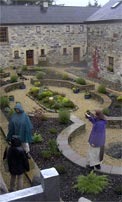 The afternoon is a highlight of the trip: our group's visit to Holy Hill Hermitage near Sligo. At this Carmelite monastery, we hear a short talk from Father Eric, followed by Benediction. Then we're treated to a tour of its gorgeous grounds: a statue of Mary, Jesus, and their dog (!); the monks' well-tended vegetable gardens; the hand-hewn library they're building; and their beautiful courtyard, designed around the elements of earth, water, and fire.
The afternoon is a highlight of the trip: our group's visit to Holy Hill Hermitage near Sligo. At this Carmelite monastery, we hear a short talk from Father Eric, followed by Benediction. Then we're treated to a tour of its gorgeous grounds: a statue of Mary, Jesus, and their dog (!); the monks' well-tended vegetable gardens; the hand-hewn library they're building; and their beautiful courtyard, designed around the elements of earth, water, and fire.
The hermitage dogs (one's named Duende) bound about as we help the monks set the table in the dining room--or is that "refectory"? As we settle down to a meal of delicious homemade bread and seafood chowder, group members discuss the hermitage's reproduction of Rembrandt's famous painting, The Return of the Prodigal Son. In it, as Henri Nouwen and others have noted, one of the father's hands appears feminine, the other masculine.
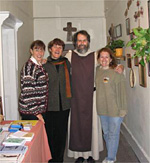 The evening closes with a Four Elements ritual in the chapel, where words from the Psalms, St. Francis, Chief Seattle, and the Sioux Indians combine. The 15-minute ceremony begins "Earth I am/Air I am/Fire, water, spirit I am."
The evening closes with a Four Elements ritual in the chapel, where words from the Psalms, St. Francis, Chief Seattle, and the Sioux Indians combine. The 15-minute ceremony begins "Earth I am/Air I am/Fire, water, spirit I am."
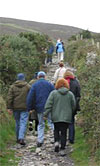 We set off on the long-anticipated hike to Maeve's Mound, burial cairn of a colorful heroine of Irish mythology. As we drive along the gorgeous seacoast to the mountain, Carl regales us with tales of the Irish warrior queen's heroic--and lusty--escapades. She's at least as feisty as Maureen O'Hara in "The Quiet Man," he assures us. (Those who don't choose to hike take our tour bus to nearby Carrowmore, one of the world's most ancient megalithic burial sites.)
We set off on the long-anticipated hike to Maeve's Mound, burial cairn of a colorful heroine of Irish mythology. As we drive along the gorgeous seacoast to the mountain, Carl regales us with tales of the Irish warrior queen's heroic--and lusty--escapades. She's at least as feisty as Maureen O'Hara in "The Quiet Man," he assures us. (Those who don't choose to hike take our tour bus to nearby Carrowmore, one of the world's most ancient megalithic burial sites.)
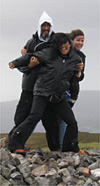 It's quite a blustery day, though there's no rain. Avoiding presents from our sheep friends, who scatter when we approach, we reach the summit in an hour. There, the winds are nearly gale force. Undaunted, our hardy crew climbs up the rocky burial mound and surveys the Atlantic.
It's quite a blustery day, though there's no rain. Avoiding presents from our sheep friends, who scatter when we approach, we reach the summit in an hour. There, the winds are nearly gale force. Undaunted, our hardy crew climbs up the rocky burial mound and surveys the Atlantic.
Overheard: A newly-coined hiker's mantra: "Tufty grass good, slippery moss bad."
 On the way down, we sample some blackberries along the path and pause for pictures near a short, gnarled fairy tree; Carl notes that such trees are always solitary and often thorny. We set off an afternoon drive to Dublin, listening to joke CDs of Irish comedians Hal Roche and Brendan Grace, and then watch "Singin' in the Rain." Shopping and fun in Dublin that night, with several group members tracing the steps of James Joyce.
On the way down, we sample some blackberries along the path and pause for pictures near a short, gnarled fairy tree; Carl notes that such trees are always solitary and often thorny. We set off an afternoon drive to Dublin, listening to joke CDs of Irish comedians Hal Roche and Brendan Grace, and then watch "Singin' in the Rain." Shopping and fun in Dublin that night, with several group members tracing the steps of James Joyce.
Day 7--Tara and Newgrange
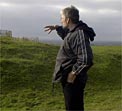 We take an easy day trip from Dublin to nearby pre-Christian, earth-based sites. First stop is Tara, burial mound of Ireland's ancient kings, revered as a threshold to the afterlife.
We take an easy day trip from Dublin to nearby pre-Christian, earth-based sites. First stop is Tara, burial mound of Ireland's ancient kings, revered as a threshold to the afterlife.
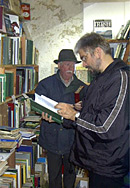 After spending a wee bit longer than we should in a roadside bookshop, we stop briefly at the spot where, according to legend, St. Patrick lit the flame of Christianity for Ireland. Not to be outdone by the patron saint, one of our participants lights her lighter and holds it aloft.
After spending a wee bit longer than we should in a roadside bookshop, we stop briefly at the spot where, according to legend, St. Patrick lit the flame of Christianity for Ireland. Not to be outdone by the patron saint, one of our participants lights her lighter and holds it aloft.
Next we visit spellbinding Newgrange, a prehistoric burial mound where once a year, during the Winter Solstice, a shaft of light illuminates the inner chamber. Huddled deep inside the chamber, we peer at millenia-old Celtic designs with three circles intertwined--pagan symbols that, some Christians say, prefigured the teaching of the Trinity. Through the miracle of modern technology, the Newgrange staff is able to create the solstice light for us.
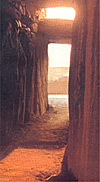 Quotable: Newgrange guide says "The ancients built this mound five thousand years ago and there's never been a drop of water inside. Our visitor's center is three years old and we're having trouble keeping the rain out."
Quotable: Newgrange guide says "The ancients built this mound five thousand years ago and there's never been a drop of water inside. Our visitor's center is three years old and we're having trouble keeping the rain out."
Back in Dublin that evening, we toast our spiritual journey at a three-hour farewell dinner, complete with speeches and revelations. A non-Christian says the trip helped her understand Christianity--especially Catholicism--better, and "look beyond the dogma." A Catholic participant thanks Carl for his insights and says she's "honored to call him my first pagan friend."
As the blessings fly, we prepare to take home what we've learned: a love for God, the earth, and one another. And we hope to hold on to what one participant called the trip's "God-intoxicated moments, full of the warmth of God's embrace and the ecstasy of living!"

